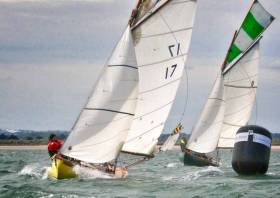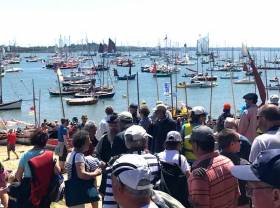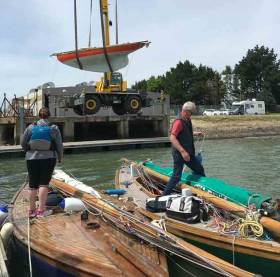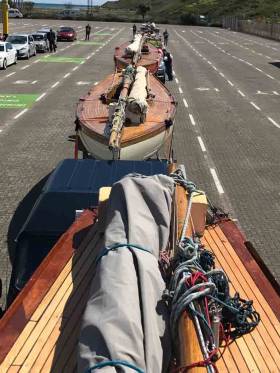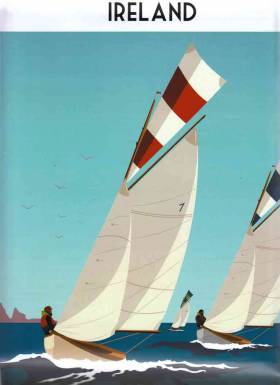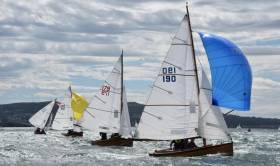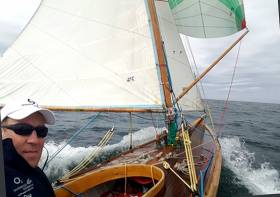Displaying items by tag: Howth 17
With the world’s newest One-Design Keelboat class, the Volvo 65, currently celebrating its hugely successful debut in the Fastnet Race 2017, it’s more than appropriate that the world’s oldest keelboat OD, the 1898-vintage Howth Seventeen, should be staging its Annual Championship, starting tomorrow (Friday evening, August 11th) at Howth Yacht Club northeast of Dublin, where the class first raced on May 4th 1898 writes W M Nixon.
All five of the original boats which sailed in that maiden race 119 years ago are still with the class, and in fact two of them, Aura (Ian Malcolm) and Leila (Roddy Cooper) were respectively second and third overall in the 2016 Championship.
It was quite an achievement, as the class has expanded over the years, and the defending champion this weekend is the Massey syndicate’s Deiliginis, one of the “new” boats, as she was built in 1907. There have been other additions since, and just recently, as reported in Afloat.ie, class numbers rose to 21 with the arrival of the new Orla, constructed in France for Ian and Judith Malcolm by the boat-building school Skol ar Mor.
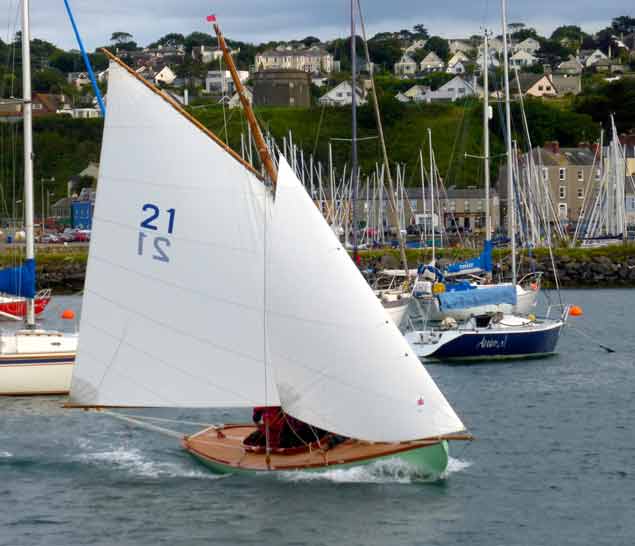 The new French-built Howth 17 Orla will be making her championship debut on Friday evening. Photo: W M Nixon
The new French-built Howth 17 Orla will be making her championship debut on Friday evening. Photo: W M Nixon
Although 21 boats are in existence, there’s always one or two resting or undergoing restoration. So the turnout this weekend will be 17 boats, with every last one of them determined to beat the new boat Orla, which will be sailed by Ian Malcolm. His other boat, the 119 year old Aura, will be raced by Puppeteer ace Scorie Walls, who has shown herself capable of winning in just about every type of boat, thus the needle between Aura and Orla will be a wonder to behold.
The championship is in a very civilized format, with the topsail-less Club race from a pier start on Friday evening, and then four races back-to-back on Saturday from the Committee Boat, with topsails in use if conditions suit. Ideally, the five races completed by Saturday evening will constitute the championship, but Sunday is kept in reserve, and has been needed a couple of times in the past.
Morbihan Tides Are No Picnic for Sail Festival Fleet
When you’ve an inland sea well filled with islands, the tides running between them are bound to be quite strong from time to time writes W M Nixon. After the second day of the Morbihan Festival of Sail, the veteran visitors from Ireland – fourteen Water Wags from Dun Laoghaire and six Howth Seventeens – are wondering if there’s ever any significant time lapse between very determined tides running one way or another.
They’ve been experiencing all this before the more structured part of the programme, which for some classes in the 1400 boat fleet will include proper racing, finally gets under way tomorrow (Wednesday) morning. For Irish crews, it all looks like being a bit of a culture shock. The starting signals start going at 0900hrs. And at this mega-event, the word is that when they say 0900hrs, they mean 0900hrs.
So today was the final countdown of taking it easy. Taking it easy at the Morbihan consisted of selecting a beach for a fleet picnic, and then making a point of everyone sailing there. With strong sunshine but light summery winds, it took at least two hours to dodge inside the tides when possible in order to reach the venue, where everyone continued to be boggle-eyed with wonder at the size of the fleet.
However, the tide was still flooding when they headed for home, and they came back in less than 45 minutes. But they need a bit of racing by the Wednesday. Too much of this lotus-eating couldn’t be for the long-term good of those involved. And as for picnics, our photo yesterday (which we can’t resist re-using today) showed that when it comes to picnics, the Water Wags have incomparable form. They know a thing or two about doing sailing picnics properly. None of your vulgar baseball caps in 1887...
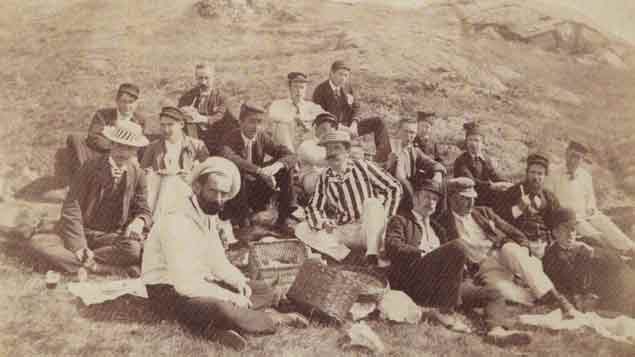 This is how you should dress for a sailing picnic....The Water Wags at The First Picnic on Dalkey Island, June 21st 1887. Photo courtesy Water Wags
This is how you should dress for a sailing picnic....The Water Wags at The First Picnic on Dalkey Island, June 21st 1887. Photo courtesy Water Wags
When you’ve 1400 sailing boats gently milling about, all in seemingly amiable confusion but with lots of warm sunshine, it’s an achievement to avoid a collision, and it’s a real breakthrough when you can recognise another participant writes W M Nixon.
For the 20 vintage Irish boats taking part in the Morbihan Festival of Sail in France – 14 Water Wags and six Howth Seventeens – yesterday’s opener with the inaugural Parade of Sail provided a flavour of what’s to come throughout the week. And last night, those whose boats didn’t provide some sort of overnight accommodation found themselves locating their homes for the week among hundreds of other shore-wandering sailors who’d spent the day being enchanted at the sight of so many boats of so many different shapes and sizes.
For that’s what the Morbihan Festival is ultimately all about. It’s an endless visual feast for all boat nuts of the true sailing kind. On the first day, you just keep gazing around you in wonderment. But after a while, you can even start on a bit of specific identification and analysis. That will begin today Tuesday – Day 2.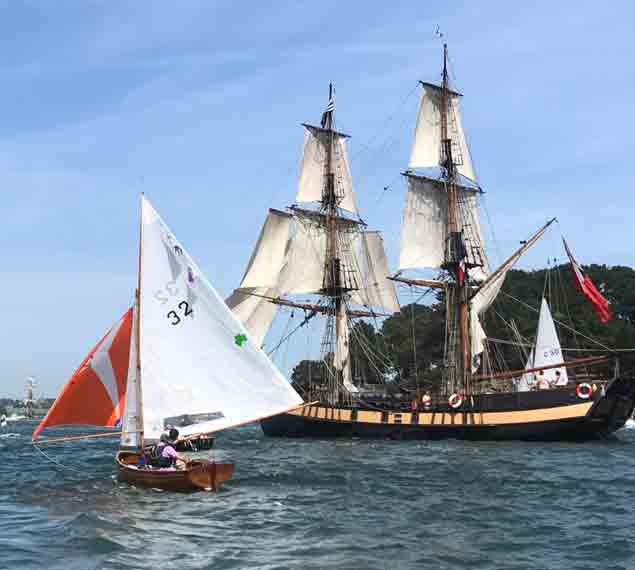 The 1985-built Water Wag Skee (named in honour of legendary boat-builder Skee Gray) shows a bit of racing experience with an effectively setting spinnaker and some interesting company
The 1985-built Water Wag Skee (named in honour of legendary boat-builder Skee Gray) shows a bit of racing experience with an effectively setting spinnaker and some interesting company
Howth 17s into Extra Time Getting Rigged in France
Howth 17 sailors are nothing if not optimists writes W M Nixon. They need to be, sailing a fleet in which the five oldest boats date back to 1898. Yet as reported on Saturday, everything was going fine with all six boats of the “Flotilla for France” road-trailed in record time to Vannes at the Morbihan in southern Brittany for the biennial Festival of Sail, in which an astonishing 1400 boats of all shapes, sizes and rigs (including 14 Dublin Bay Water Wags) will be taking part.
On Sunday,in the hot afternoon sun, the wheels came off the Howth 17 schedule ever so slightly. But as usual with this crew, it was all right in the end. A mobile crane had been optimistically booked for just one hour to launch all six, and step their masts. Perhaps being a Sunday, they wouldn’t have found any crane driver prepared to commit three hours to this sort of thing. Be that as it may, that’s what it took, for these boats need to be handled with care. And while their masts may be short, they’re heavy and tricky items, with a lot of rigging of all sorts for such a short spar.
However, they’re now all rigged, everyone is in recovery mode, and they’ll be having their first Morbihan sail this morning. Meanwhile, we hope the word doesn’t spread in the Morbihan Crane-hire Community that the Awkward Squad are in town. For in a week’s time, this “Flotilla for France” will have to be un-rigged and lifted out again. But being Howth 17 sailors, they won’t worry about that until the time comes.
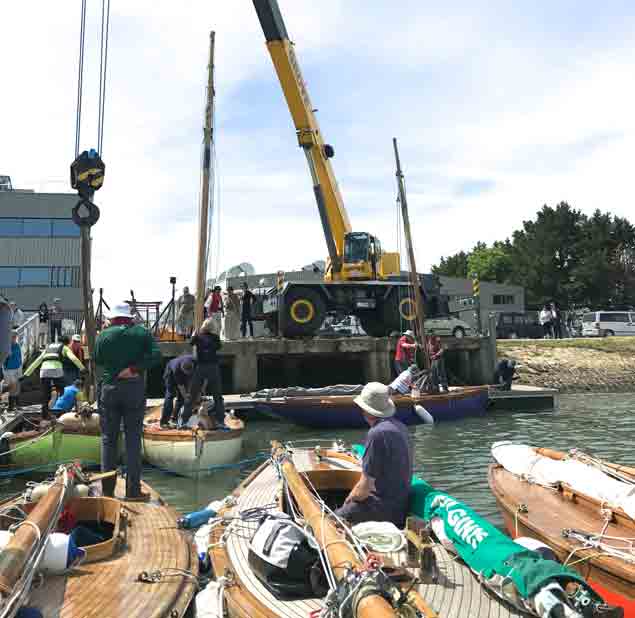 For such short masts, the Howth 17s’ sticks take a surprising anunbt of rigging. The crane had been booked for one hour for the tntie aunc-and-rig operation, but it took three. Photo: Judith Malcolm
For such short masts, the Howth 17s’ sticks take a surprising anunbt of rigging. The crane had been booked for one hour for the tntie aunc-and-rig operation, but it took three. Photo: Judith Malcolm
The 1898-vintage Howth Yacht Club Howth Seventeens haven’t survived and thrived for 119 years without being crazy like foxes now and again writes W M Nixon. So when six of them set off for Rosslare yesterday on their way to La Semaine du Golfe du Morbihan with its fleet of 1400 other interesting boats, they were happy to let the world think that Irish Ferries’ generosity in providing then with free tickets for four of the boats and their towing vehicles meant they’d have to take the long route via Irish Ferries’ main French service, which is Rosslare–Cherbourg.
But hidden there in Irish ferries’ increasing crowded timetable to France, there are less frequent but very direct services from Rosslare to Roscoff in Brittany. And the Howth Seventeens were on it yesterday evening. But they liked having their “classic rivals” in the Dublin Bay Water Wags – fourteen of whom travel Cork to Roscoff later this afternoon – think their freebie involved having to go the long way via Cherbourg.
Maybe the secret of the Howth Seventeens’ longevity is they have never grown up. Schoolboy pranks and springing surprises like this have been part of their DNA since 1898. From Roscoff to Vannes on the Morbihan is but a hop, skip and jump, and the Howth boats had got there by lunchtime today, long before the Water Wags had even left Ireland. And though the Howth Seventeens won’t have a launch slot until until 2.0pm tomorrow (Sunday), even that hasn’t softened their cough. They now have plenty of time to go and see the new Howth Seventeen being built for Ian and Judith Malcolm at the famous Skol ar Mor, just far enough down the road to provide an agreeable scenic excursion without having to think about boats under tow behind.
Ireland’s oldest keelboat class, the Howth 17s which were founded in 1898, saw six of their boats depart Rosslare at 1600hrs today writes W M Nixon. All six have safely covered the first road stage of their long haul from Howth to the week-long Festival of the Sea on the Morbihan in southern Brittany.
Irish Ferries is so taken with the venture that they have provided free return passages for four of the flotilla and their towing vehicles. The group sharing of the cost of the remaining two extra boats has made it all a very manageable financial proposition indeed.
However, there’s still a long way to go to Vannes once they’ve disembarked tomorrow morning in Cherbourg. And as two of the boats – Roddy Cooper’s Leila and Ian Macolm’s Aura – are true vintage, being of the first five built by John Hilditch in 1898, they are not so much boats now, they’re rather more in the category of sacred relics.
Irish Sailing's Classic Boats Get The French Morbihan Mystique
Three weeks hence from this morning, on Saturday May 19th, an unlikely convoy of vehicles with a very special collection of unique vintage boats and people will emerge in Cherbourg from Irish Ferries’ ship just in from Rosslare writes W M Nixon. Meanwhile, well to the west in northern Brittany, a similarly rare group with antique boats of a different type will have disembarked in Roscoff from the Brittany Ferries vessel from Cork. By that night, if all goes according to plan, both groups – people and boats alike - will be united a long way away, in the little port of Arradon on the shores of the Morbihan, the island-studded inland sea at the heart of its own Department, the most southerly part of Brittany.
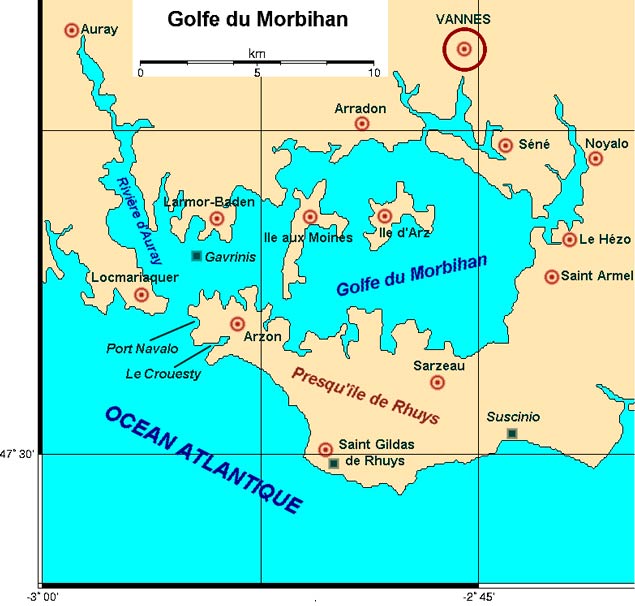 A sailing paradise. In detail, there are sixty islands in the Morbihan. The Irish crews in the Water Wags and Howth 17s will be based at Arradon on the north shore.
A sailing paradise. In detail, there are sixty islands in the Morbihan. The Irish crews in the Water Wags and Howth 17s will be based at Arradon on the north shore.
The Irish classic boats and those who sail them will have arrived to immerse themselves in the fleet of more than 1,300 other unusual craft in a very French celebration of sailing and pride in individualistic boat ownership. It’s a wonderfully complex biennial celebration which uses the magic waters of the Morbihan, where sea and land completely intertwine in the midst of the sweetest countryside with enchanting village ports, to provide a unique playground for boats of all types and sizes.
 The replica of Peter the Great’s 1703-built Shtandard will be one of the largest vessels at the Morbihan.
The replica of Peter the Great’s 1703-built Shtandard will be one of the largest vessels at the Morbihan.
At the time of writing, they’re expected to range in size from the extraordinary Russian re-creation of Peter the Great’s huge warship of 1703, the Shtandart, right down to a selection of the sometimes decidedly unusual yet effective little craft which emanate from the creative minds to be found in Francois Vivier’s design office. In between, we’ve everything from the America’s Cup 12 Metre France through a comprehensive selection of traditional sailing fishing boats and classic yacht from several maritime nations, and on through a goodly fleet of other traditional craft with a strong representation of the Bantry Boats, until at the lower end of the size scale, we find some little boats which are very odd indeed, owner-designed craft which can best be categorized somewhere on the scale which ranges from Rather Quirky to Utterly Bonkers.
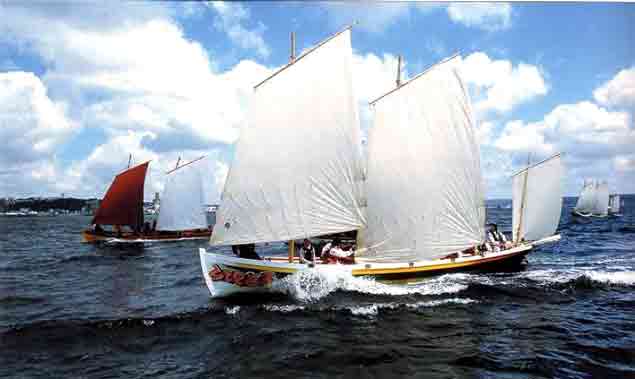 Bantry Boats racing in France. Based on the ship’s boat left behind in Bantry Bay after the failed invasion of 1796, the Bantry boat was stored for more than a hundred years at Bantry House before being moved to the National Museum. Under an iniative inspired by Hal Sisk, they are now the basis of a lively fleet on both sides of the Atlantic, and will be a feature of the Morbihan Week.
Bantry Boats racing in France. Based on the ship’s boat left behind in Bantry Bay after the failed invasion of 1796, the Bantry boat was stored for more than a hundred years at Bantry House before being moved to the National Museum. Under an iniative inspired by Hal Sisk, they are now the basis of a lively fleet on both sides of the Atlantic, and will be a feature of the Morbihan Week.
 They’re in better heart than ever. The Water Wags at a recent “training weekend” at Killenure on Lough Ree. Next month they will be making their second visit to the biennial Morbihan Week in southern Brittany.
They’re in better heart than ever. The Water Wags at a recent “training weekend” at Killenure on Lough Ree. Next month they will be making their second visit to the biennial Morbihan Week in southern Brittany.
In the midst of the huge fleet, there’ll be twelve Water Wags and six Howth 17s from Ireland. Small and all as they are by comparison with some of the enormous traditional fishing craft and Tall Ships taking part, they will be accorded honoured status partly on account of age. The Water Wags of 1887 origin, with the present class a re-worked larger design from 1900, introduced the One-Design concept. And as the Howth 17s are of 1898 origin, they are accorded the special honour of being the world’s oldest one design keelboat class still sailing as originally designed.
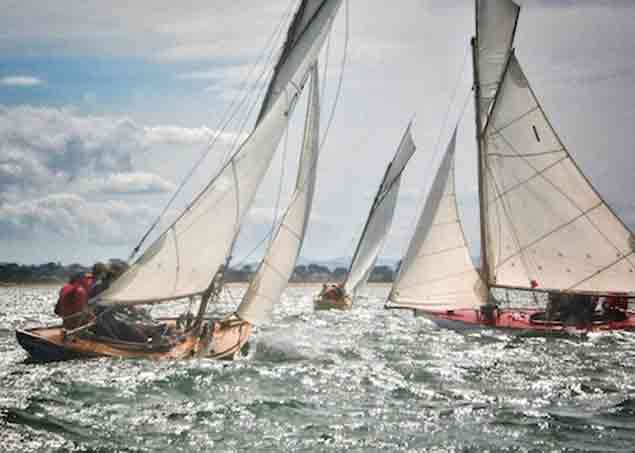 Howth 17s in full cry. They will be making their first visit to the Morbihan festival, but their newest sister-ship is being built nearby at Skol ar Mor.
Howth 17s in full cry. They will be making their first visit to the Morbihan festival, but their newest sister-ship is being built nearby at Skol ar Mor.
Further to all that, both classes bring international status through coming from Ireland, and few have come further, even if the little Irish boats are sensibly using the ferries. But we will also see Irish Sea representation with boats which have sailed there, with the beautifully restored classic Laurent Giles-designed Carbineer 46 Sylvana voyaging from Northern Ireland, while the irrepressible Joe Pennington from the Isle of Man is entered with his restored 1895-built 36ft Manx longliner Master Frank, which might find it interesting to have a spot of competition with the comparable French-based Essex smack Unity of Lynn.
However, for the little Irish boats, it’s a formidable logistical challenge. The Water Wags - in which the Olympic Mother Cathy MacAleavey has been setting the racing pace of late, though David MacFarlane won on Wednesday – are in good hands as Carol O’Rourke is coordinating their arrangements. But anyway they’ve useful experience here, as seven of them travelled to the 2015 Semaine du Golfe du Morbihan, and eight came back. They returned with a new boat for Adam Winkelmann which had been built to the class’s ancient designs by Mike Newmeyer and his team at the inspirational boat-building school Skol ar Mor.
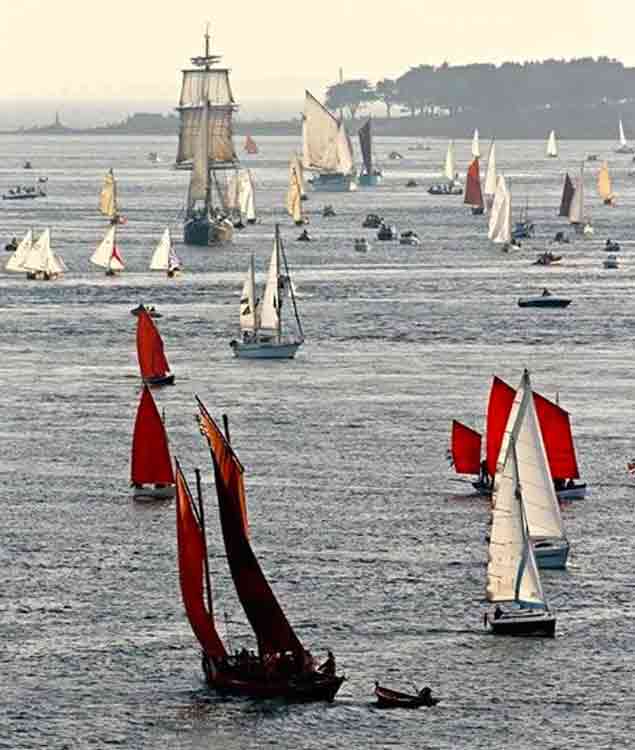 Eclectic fleet......the Morbihan Fesitval in 2015. Four of the Water Wags are just about visible left centre
Eclectic fleet......the Morbihan Fesitval in 2015. Four of the Water Wags are just about visible left centre
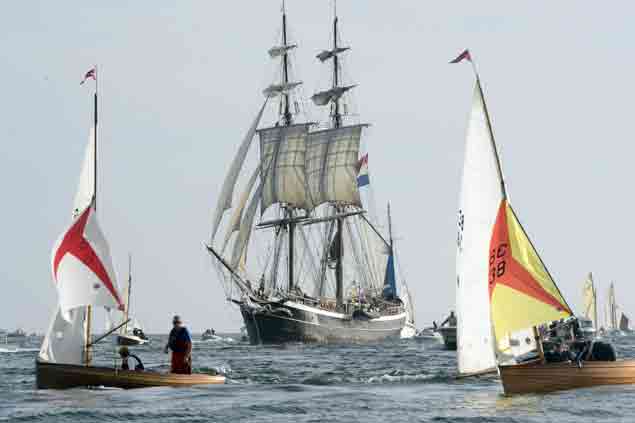 The popular Dutch sail training ship Morgenster was a welcome visitor to the festival in 2015, and is seen here approaching the entrance to the Morbihan in company with a couple of Water Wags
The popular Dutch sail training ship Morgenster was a welcome visitor to the festival in 2015, and is seen here approaching the entrance to the Morbihan in company with a couple of Water Wags
Skol ar Mor – which is located near the entrance to the Morbihan – is currently building a new Howth 17 for Ian and Judith Malcolm, but she won’t be finished until July as her construction is timed to phase in with the school’s term periods. But in any case, the Malcolms are keen to make their debut for the Howth 17s at Morbihan with their 1898-vintage boat Aura, which they’ve owned, lovingly cared for and raced very regularly since 1980.
It’s not the first time the Howth 17s have travelled far from their ancestral home, in fact it’s not the first time they’ve been to France, as a trio went to the Brest Festival in 1972. But road travel technology for little old boats wasn’t so advanced 45 years ago, so it wasn’t until 1998 that another road migration was taken on, with seven of them going to Belfast Lough to celebrate their centenary at their birthplace at Carrickfergus. They sailed the 90 miles home.
Then in 2005 they’d a seriously major movement, when an incredible 15 managed to get to the Glandore Classics involving an efficiently-organised set of low loaders which could take the boats down to West Cork three or even four at a time.
The Howth 17s are nothing if not individualistic, so the regimentation essential to the success of this expedition was exhausting for them. It took a while for the normal busy season of racing (usually they’ve sixty races a year) to resume once they’d got home. So since then, they’ve been building up a group of owners within the class who have proper road trailers, and that was the means used to get seven boats to Belfast Lough for last year’s 150th Anniversaries of Carrickfergus Sailing Club and Royal Ulster Yacht Club, together with the celebration of the yacht and boat-building achievement of the John Hilditch yard at Carrickfergus.
 The opportunity to compare different rigs and boat types at the Morbihan is unrivalled. This is the Looe Lugger Our Boys of Plymouth..........
The opportunity to compare different rigs and boat types at the Morbihan is unrivalled. This is the Looe Lugger Our Boys of Plymouth..........
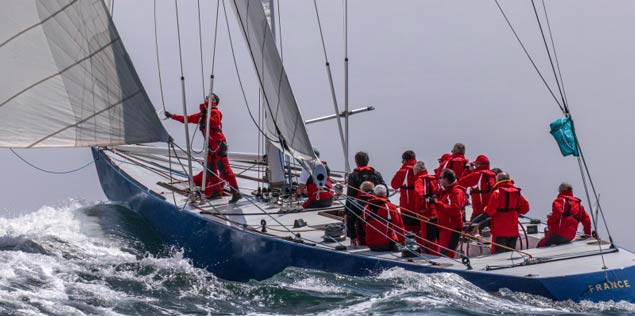 ......and this is the former America’s Cup 12 Metre France
......and this is the former America’s Cup 12 Metre France
But there’s a heck of a difference between taking just part of a morning to road-trail mostly on motorways from Howth to Bangor, and trailing your boat from Dublin to the Morbihan via the Rosslare-Cherbourg ferry. The Water Wags know they can do it, but for the much heavier Howth 17s and their interesting selection of four-wheel-drive towing vehicles, they’re facing a total haul of 540 kilometres, 348 of them in France.
Naturally, there are those who’ll say that boats of this vintage should live pampered lives. But the Howth 17s are nothing if not adventurous, and Irish Ferries have been so much taken with all this that four of the boats and their towing vehicles are travelling the ferries there and back for free, so between them the six travelling equipes have only had to divvy up for two boats’ cost.
Nevertheless as two of the boats – Aura and Roddy Cooper’s Leila - are from the original 1898 Hilditch-built five, they’re moving a uniquely precious cargo on a project very far removed from their origins. So far removed, in fact, that I can’t help but imagine John Hilditch urging on his men on a Monday morning early in the Spring of 1898 with the inspiring words: “C’mon, lads, we have to build these new Howth boats strong and true, for in 119 years time their owners will want to trail them the 217 miles from Cherbourg to Vannes on some sort of road cart.”
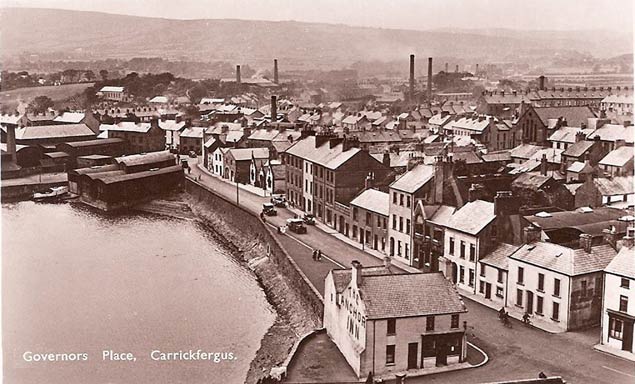 Change of scene. The Howth 17s were built in Carrickfergus in 1898 in Hilditch’s Boatyard in those black sheds on the waterfront at the head of the harbour in an industrial town.......
Change of scene. The Howth 17s were built in Carrickfergus in 1898 in Hilditch’s Boatyard in those black sheds on the waterfront at the head of the harbour in an industrial town....... ....but next month they’ll be sailing in these agreeable surroundings in the heart of the Morbihan
....but next month they’ll be sailing in these agreeable surroundings in the heart of the Morbihan
Quite. Either way, it will be an exhausting journey, but it’s the sort of project which re-energises those involved as it moves along, and once they’ve got to the Morbihan, the Water Wag and Howth 17s sailors will find themelves among kindred spirits. It’s something they need from time to time. Only the other day I was asked to reveal to a non-sailor what the Water Wags are all about in 2017, and found it very challenging. For how can you explain the inexplicable?
Around the Morbihan, there’ll be no need to explain. Yet even in France supposedly among members of the same nautical religion, the Howth 17s and the Water Wags will find themselves slightly at odds with the crew of some other boat types, as the essence of both the Irish classes is that they race a lot, so much so that both classes are healthier than ever. But that is not always to the taste of all those who simply love old boats for themselves, and find that keeping them in good order and sailing them in non-competitive style on various expeditions within the ambit of the Semaine du Golfe du Morbihan is all that is required.
But the Morbihan has so much to offer that there’s something for everyone, and for smaller racing boats that want racing, there’ll be racing available. As for others who simply like sport in sailing challenging bits of sea, the tides in the Morbihan whoosh in and out through the narrow entrance with such vigour that many treat it like a nautical ski slope.
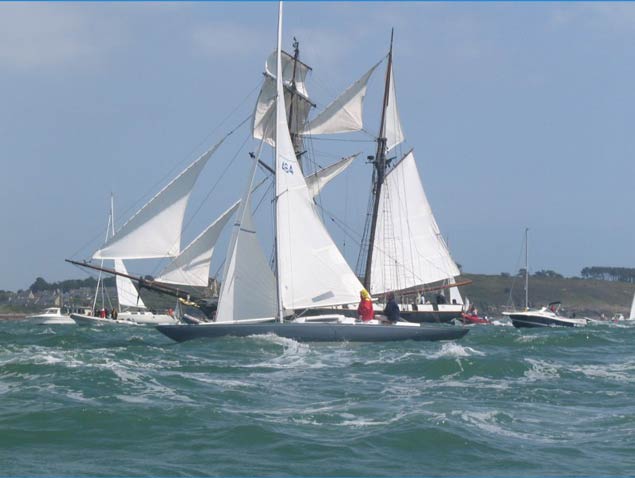 The manageable liveliness of the tide-riven waters in the Morbihan entrance is integral to the way the event is staged.......
The manageable liveliness of the tide-riven waters in the Morbihan entrance is integral to the way the event is staged.......
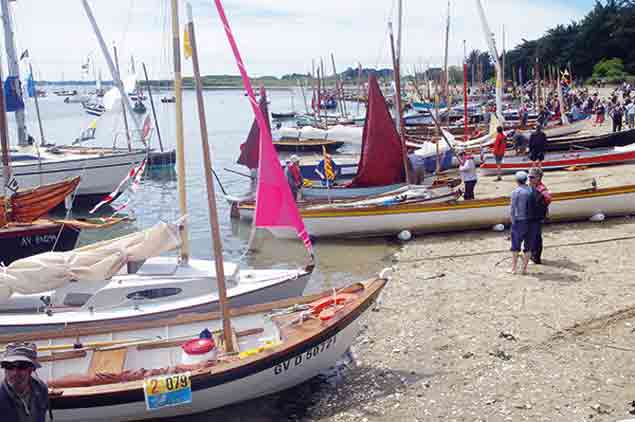 ......but for balance, sheltered beach time is expected
......but for balance, sheltered beach time is expected
This is markedly unlike the attitude at the entrance to Strangford Lough. There, the tide-race on the bar is admittedly on a bigger scale, but it’s regarded as something to be avoided. At the Morbihan by contrast, there are small boat sailors who’ll spend their whole day crawling in the eddies against the tide, and then returning with it in the middle of the full exuberant burst of the rip.
For those with more leisurely tastes, there are all sorts of waterside establishments where lunch can go on for ever, but be very sure to have secured your table by 12:30pm. And as for visiting other boats, that too can go on for ever.
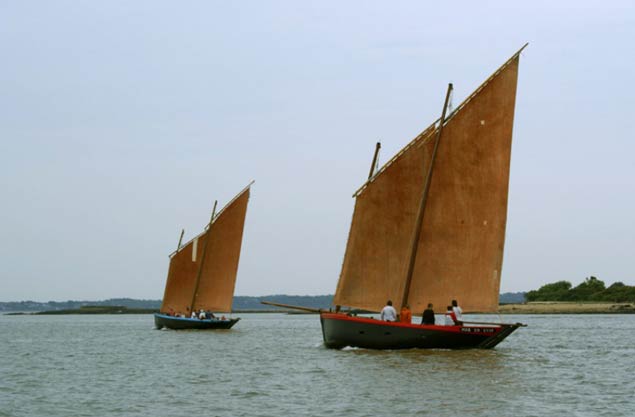 The sinagot is the indigenous traditional fishing boat of the Morbihan
The sinagot is the indigenous traditional fishing boat of the Morbihan
Certainly there are some with which the Howth folk should link up. A noted presence will be the McGruer 8 Metre Cruiser/Racer Orana of 1959 vintage. For many years she was based in Howth under Johnny Pearson’s ownership, and she had her moments, including winning the 1966 RORC Beaumaris-Cork Race overall. She was the first yacht I ever did the Lambay Race aboard, and when you do your first Lambay Race with the likes of Johnny Pearson, Bob Fannin and Brendan Murray, you learn an awful lot about what living in Howth is going to involve, and you even learn a little about racing round Lambay.
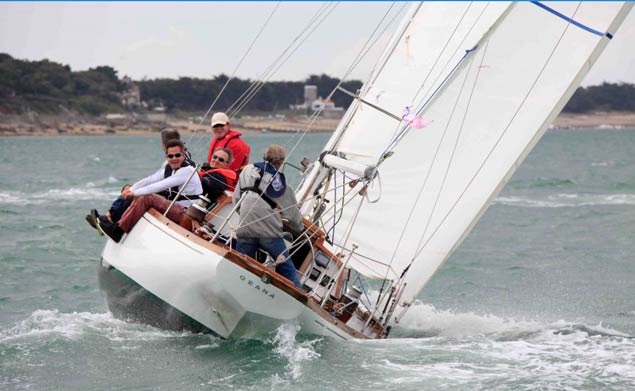 The 1959 McGruer-designed 8 Metre Cruiser-Racer Orana was Howth-based for many years, and was overall winner of the 1966 RORC Beaumaris-Cork Race. After being under the radar for decades, she has re-emerged in French ownership as a participant at Morbihan Week 2017
The 1959 McGruer-designed 8 Metre Cruiser-Racer Orana was Howth-based for many years, and was overall winner of the 1966 RORC Beaumaris-Cork Race. After being under the radar for decades, she has re-emerged in French ownership as a participant at Morbihan Week 2017
Orana had been off the radar for decades, but now she has re-emerged, spic and span in French ownership and ready to strut her stuff in the Morbihan in three weeks time when she’ll be part of a mind-blowing feet. In fact, so diverse is the fleet, that while most of it will be the challenge of recognising what’s going past, some are worth seeking out directly, and one such is surely the famous Pen Duick, Eric Tabarly’s original boat, a Fife-designed 15-tonner which started life in 1898 at Carrigaloe on Cork Harbour.
Originally, she was given the unlovely name of Yum, and her owner, one Adolphus Fowler of the Royal Munster YC, was evidently feeling prosperous, for at the same time he had the Carrigaloe yard built him the Cork Harbour One Design Jap.
Both boats still sail the sea, but mercifully Yum soon received a pleasanter name as she was quickly sold, and she is now immortalised as Pen Duick, the eternal beauty brought back to life by Eric Tabarly to be an extraordinary link between William Fife of Scotland, Cork Harbour in Ireland, and all that is best in French sailing in Brittany.
In a league like this, the little boats from Ireland will need to do something special to fulfill their role. But I think that the poster that the Howth 17s commissioned from local artist Carol O’Mara for display on the various sites around the Morbihan is definitely a step in the right direction. There’ll be so many messages flying around from all sources that something which says what it wants to say so well, so simply, and so directly will make the most impact.
Howth Yacht Club's Classic Boat Championships Finishes in Style for Mermaids & Howth 17s
The Howth Yacht Club hosted the Classic One-Design Regatta - incorporating the National Championships of the Dublin Bay Mermaid and Howth 17 Footer classes. Download Mermaid results below. Even before you could see them, the vapour of varnish bumbled over the hills and lowlands into Howth. Facebook updates from sailors on motorways passing shiny timber creations confirmed that the Mermaids were officially on tour. Some arrived under cover of darkness and were only noticed early on Thursday morning with a full dinghy pen. Little sailors, just starting out on their sailing careers, couldn't even see over the gunwhales of these big dinghies. They oohed and ahhed at boats made from "actual timber?"
Twenty-three Mermaids were weighed and plopped into Howth Harbour. Some of them had been here relatively recently (1953!) and wondered who had stolen Howth Sailing Club. HYC's Jedi, Neville Maguire was on hand with fellow Mermaid aficionados Gerry and Ian Sargent to poke and point and raise eyebrows at things called "Cleats".
Under the care of National Race Officer Scorie Walls, Thursday's racing started at a polite 1400. Keeping the Northside flag held high, "Azeezy" from Skerries did the business with two wins from three races. Not content with competing with eachother on the water, the Annual Mermaid Table Quiz followed rehydration. In a show of poor manners, a table made up almost entirely of Howth 17 Footers won. A prize was awarded for the best answer to "What is the capital of Mongolia?" "Don't know, but it's got a lot of vowels and sounds fierce foreign".
Two races for the Mermaids on Friday saw "Wild Wind" (Rush SC) and "Tiller Girl" (National YC) equal "Azeezy"'s daily tot of 6 points. The gap wasn't closing.
Howth history in the making was being mentioned all week before the old ladies of sailing, the Howth 17 Footers, put on their Friday night frocks and took to the water for a single race from the East Pier. For the first time in history, 18 boats were afloat and jockeying for position. The busy start line was made slightly more complex when the class was given a downwind/ spinnaker start in front of the East Pier, with boats gybing and tacking simultaneously as they jockied for position with a minute to go. Almost inevitably for the class, the girls began the bumping and grinding before the start signal and "Oona" went for "Rita" like a jealous girlfriend. "Rita’s” stick-man, Marcus Lynch, found himself with a clip around the ear from "Oona's" bowsprit and was forced to retire with injured planks, cracked frames and a split rudder. Turns out that "Oona" picked the wrong girl to shout at and she broke her bowsprit in the collision. And so the anticipated race with the full compliment of the world's oldest one-design racing keelboats never quite happened. The remaining seventeen boats crossed the line with spinnakers flying and more photographers clicking than at a Justin Bieber underwear collection launch. Head girl was "Deilginis" with "Aura" and "Hera" following in her tracks.
Saturday morning saw the Howth 17 Footers dressing up in their finest gowns and bonnets and gliding like debutants to the dancefloor. "Hera" lifted up her skirt and frightened the girls by winning by over two minutes. The brazen thing. She would have to have her cough softened! "Deilginis" took back control of the crowd in Race 3, trailed by "Gladys" sporting her 2016 Spring/Summer collection.
By the middle of the day, the wind had picked up, gusting over 30kts, and it was become hard for some to keep the bonnets atop. The ladies rolled down the run more like drunken maids than the elegant princesses which left the Harbour. Half of the fleet chose to remove their topsails but not before the paparazzi had caught them on video, in full swing...
The Mermaids were on the far side of the trapezoid course and only crossed the Howth 17s at the leeward mark and short beat to the finish. It was likely that some Mermaid sailors were checking their insurance when they saw the 17s approach! Top Mermaid of the day was "Vee" (Rush SC) with a 1st and 4th. "Wild Wind" and "Tiller Girl" produced some magic to close the gap to leader "Azeezy" but it wasn't to be enough to rein in the eventual Champions.
Back on the Howth 17 course, "Leila" and "Aura" sobered and took the last two races, and "Deilginis" was to take the 2016 title. Class Captain, Tom Houlihan, took the Handicap prize aboard his "Zaida".
As the last of the Howth 17 sailors were plucked from the moorings, the Mermaids had already already been craned out and packed up, setting the scene for a packed balcony in glorious sunshine. Rehydration once more!
170 sailors and their entourages filed into the club dining room to be fed, found, watered, awarded and clapped at. Champion Mermaid sailor Sam Shiels pronounced an epic acceptance speech. His Howth 17 opposite, Luke Massey, countered it with an example of brevity and raised the trophy aloft.
The next Classic One-Design Regatta will be held at Howth Yacht Club over the weekend of 10-12 August 2018.
Round Ireland Racers ‘Are Going The Wrong Way'
What do former round Ireland trophy winners do when they don’t have time to do the race itself? Former regular in the Round Ireland fleet Dave Nixon of Howth tells us the best thing to do is sail a 109–year–old gaff sloop for a day or two in the opposite direction. He and Nick Massey set out on Tuesday to sail the 1907-built Howth 17 Deilginis to Ardglass in the first stage of a passage to Bangor, where Deilginis is joining six of her classmates (the others have been road-trailed there) with other classics such as the Strangford Lough Glens to celebrate the 150th Anniversary of the Royal Ulster Yacht Club for the next four days.
They’d a fine fair wind for the 60 miles passage to Ardglass, knocking it off in nine hours - the Howth 17s are no slouches with sheets freed. Then yesterday lunchtime with spinnaker set, they were closing in on the South Rock Light to take the new ebb northward to Bangor when clubmate Dave Cullen’s Euro Car Park appeared and tacked close head as she plugged southward in the Volvo Round Ireland race.
The message from Deiliginis’s crew is that those guys are gong to wrong way. Euro Car Parks is still strugging to get to Wickow this morning, but despite having no engine, Deilginis was comfortably into Bangor Marina yesterday evening, and is all geared up to race acres Belfast Lough to Carrickfergus today to celebrate the class’s connection with legendary boatbuider John Hilidtch of that port, who built the first five Howth 17s in 1898.
Historic Belfast Lough Boatyard Lives On Through Classic Yachts
The recreational marine industry is a demanding trade. Your customers buy boats for pleasure, so they assume it’s a fun business to work in. Thus there’s no lack of potential boat designers and builders to be found among the children of those who only sail for sport and fun, for they see that the adults enjoy being around boats, and they get to think that being around boats all the time for work and play is the only way to live.
But in the end, business is business. The bottom line rules everything else. However enthusiastic young people may have been when first going into the boat trade, as they battle on with running their own marine business they find the world of commerce can become a cruel place. W M Nixon considers the challenges of boat-building, and looks at the story of John Hilditch of Carrickfergus, who was one of the brightest stars of the Irish boat-building industry in the golden age of yachting, yet his light was extinguished after barely two decades.
The name of Hilditch of Carrickfergus is synonymous with classic yachts of significant age. John Hilditch built the 36ft G L Watson-designed cutter Peggy Bawn in 1894, and she still sails. In fact, she sails in better shape than ever, as she had a meticulous restoration completed for Hal Sisk of Dun Laoghaire in 2005.
More recently, in 2013 the Hilditch-built Mylne-designed Belfast Lough Island Class 39ft yawl Trasnagh was restored for Ian Terblanche in Devon in time for her Centenary. And in 2015, the Belfast Lough OD Class I Tern – 37.5ft LOA to a William Fife design and built in 1897 with seven sister-ships by John Hilditch - has appeared in Mallorca so superbly restored that when she went on to Les Voiles de St Tropez at the end of September, she won her class despite it being heavy weather, and she only just out of the box.
 Peggy Bawn in her first season afloat in 1894. She was built for A J A Lepper, Commodore of Carrickfergus Sailing Club, who was one of John Hilditch’s most loyal clients. Photo courtesy RUYC
Peggy Bawn in her first season afloat in 1894. She was built for A J A Lepper, Commodore of Carrickfergus Sailing Club, who was one of John Hilditch’s most loyal clients. Photo courtesy RUYC
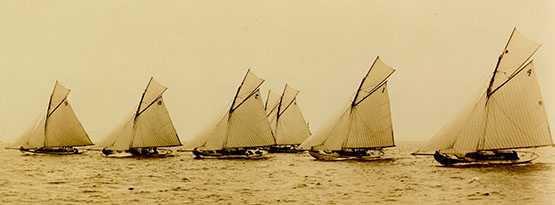
A monumental achievement. All the boats of the new Fife-designed Belfast Lough OD Class 1 of 1897 were built by John Hilditch in less than a year. Photo: Courtesy RUYC
But we don’t have to go to distant restoration specialists to find evidence of the large and varied Hilditch output. The first five boats of the Howth 17 OD class were built by John Hilditch immediately after he’d built the eight Belfast Lough Class I boats. The little new Howth gaff sloops – rigged with huge jackyard topsails as they still are today - sailed the 90 miles home down the Irish Sea to Howth in April 1898, and had their first race on May 4th 1898. All five of the original Hilditch creations continue to race with the thriving Howth 17 class, which today has eighteen boats.
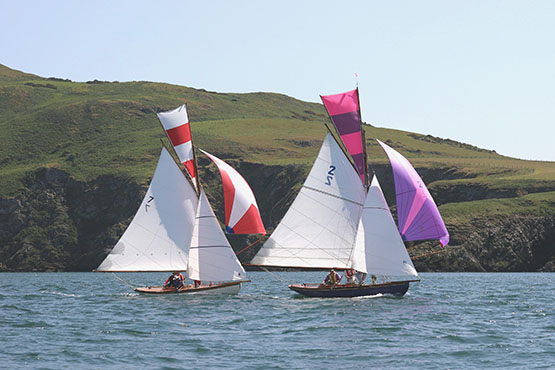
The Howth 17s Aura (left) and Pauline. Aura is one of the original five Howth 17s built for 1898 by John Hilditch immediately after he had completed the Belfast Lough Class I boats. Photo: John Deane
This concentration of yacht design development in a short time span, and through just one boatyard, is rare but not unique – the great name of Charlie Sibbick of Cowes shone equally briefly but even more brightly at much the same time, as he was a designer too. But Sibbick made his name in an established international centre for sailing. Yet when John Hilditch – who was both a seafarer and a fully-qualified shipwright – established his yard at Carrickfergus on Belfast Lough in the winter of 1892-93, the north of Ireland was still a relative backwater in international sailing terms. Thus his achievement is indeed remarkable. For by the time Hilditch closed down in the winter of 1913-14, he had put Belfast Lough firmly in the global picture as a pace-setter in yacht development, and his pivotal role in that transformation is gaining increasing recognition.
Not that there hadn’t been sailing in Belfast Lough before Hilditch came along. There are many yacht and sailing clubs around this fine stretch of sailing water, and the most senior of them is Holywood Yacht Club (on the waterfront below the hills where Rory McIlroy learned to pay golf), which dates back to 1862. And in 1866, two more new clubs came into being – Carrickfergus Sailing Club which was obviously location-specific, and the Ulster Yacht Cub, which became the Royal Ulster Yacht Club in 1869, but was a premises-free moveable feast until 1898, when America’s Cup challenger Thomas Lipton insisted it have a clubhouse, which was duly opened on an eminence close above the Bangor waterfront in April 1899.
The shared foundation year which goes back through the mists of time to 1866 means that both clubs will be celebrating their 150th Anniversaries in 2016. They’ve been quietly working on their separate plans towards celebrating this significant date, with a massive new history of the RUYC under way for a couple of years now and due for publication in the Spring, while Carrickfergus also has plans in the publication line.
Yet although there is much to write about now, in both club’s cases the pace of development was relatively slow until the late 1880s, for until that time, the business of the rapidly expanding city of Belfast was business, and more business. It wasn’t until the 1880s that leisure sailing began to get serious attention from the rapidly growing middle classes of the greater Belfast area. But once they did begin to take it up, they did so with complete enthusiasm, and the sailing pace of Belfast Lough during the 1890s, and on towards 1910, had few rivals.
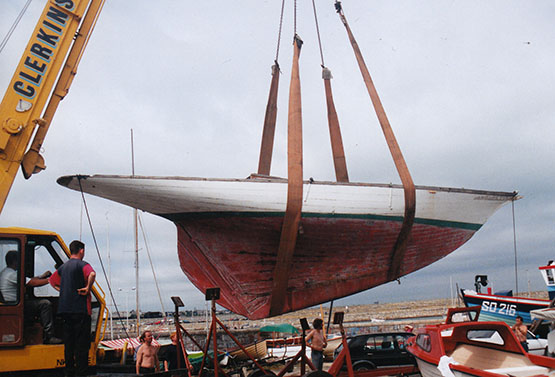
For the rapid yacht design development seen during John Hilditch’s busy years, compare this with the next image. The old-style hull of Peggy Bawn is revealed as she is lifted out of the Coal Harbour Yard in Dun Laoghaire in 1996 for a first attempt at restoration. Later, Hal Sisk took over the project, and it was completed for him by Michael Kennedy of Dunmore East. Photo:W M Nixon
 The new style shape. Although they were built only three years after Peggy Bawn, the Fife-designed Belfast Lough Class I boats had a much more modern hull shape and were primarily racing boats, yet they were required to be well capable of sailing to Scotland and Dublin Bay, and did so
The new style shape. Although they were built only three years after Peggy Bawn, the Fife-designed Belfast Lough Class I boats had a much more modern hull shape and were primarily racing boats, yet they were required to be well capable of sailing to Scotland and Dublin Bay, and did so
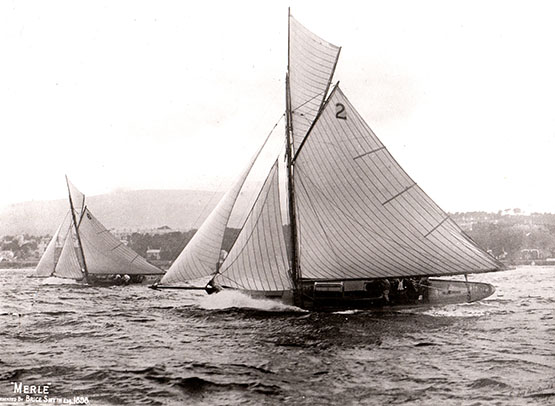 Formidable performers. The Belfast Lough Class I boats Merle (6, Brice Smyth) and Flamingo (2, John Pirrie) racing hard in 1898. Both owner-skippers were members of Carrickfergus SC, and based their boats there. Photo: Courtesy RNIYC
Formidable performers. The Belfast Lough Class I boats Merle (6, Brice Smyth) and Flamingo (2, John Pirrie) racing hard in 1898. Both owner-skippers were members of Carrickfergus SC, and based their boats there. Photo: Courtesy RNIYC
In order to meet this demand, John Hilditch was able to expand his new boatyard at an extraordinary pace. Even then, he couldn’t keep up with demand, such that one new Belfast Lough class, the Linton Hope-designed lifting-keel 17ft LWL Jewel Class of 1898, had to be built in Chester in England. And at the same time, the fishing-boat builder James Kelly of Portrush on the North Coast found that yacht-building to supply the new craze was much more lucrative than producing his own variant of the classic Greencastle yawl for fishermen on both the Irish and Scottish coasts, and he went into yacht-building both for Belfast Lough and Dublin Bay.
But in terms of overall contribution to the transformation of Belfast Lough sailing, John Hilditch was very much in a league of his own. So much so, in fact, that noted international classic sailing polymath Iain McAllister got to thinking last winter that even though no trace whatsoever now remains of this once famous yard, it was time and more for John Hilditch’s work to be celebrated, and how better than a Hilditch Regatta during 2016 to tie in with other Belfast Lough sailing celebrations?

It’s a great idea which seemed almost too good to be true. But thanks to quiet work behind the scenes, most notably by Wendy Grant who recently became Commodore of Carrickfergus Sailing Club neatly in time to hold the top post during the 150th celebrations (she’s the mother of renowned offshore navigator Ian Moore), plus a special sub-committee in RUYC which likewise holds to the notion that the early stages of good work are best done by stealth, a programme is emerging which will keep all organising parties happy while providing participants with a manageable user-friendly schedule.
It has all become viable during this past week thanks to the confirmation that the more distantly-located significant classic boats of the Hilditch oeuvre – Peggy Bawn of 1894, Tern of the 1897 Belfast Lough Class I, the Howth 17s of 1898, and Trasnagh, the Island Class yawl of 1913 – all hope to be in Belfast Lough towards the end of June 2016, where numbers will be further swollen by the Hilditch-built Royal North of Ireland YC Fairy Class of 1902, together with some of their sister-ships from Lough Erne.
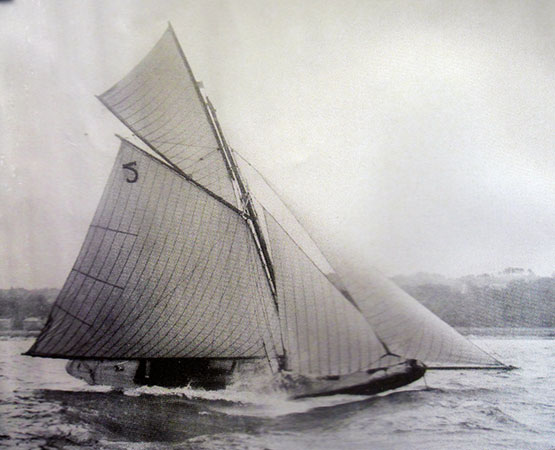
The Hilditch-built Tern in a breeze of wind on Belfast Lough, 1898
Tern in a breeze of wind at St Tropez, September 2015.
In addition, the fleet will be increased by other classics of every type, coming together to wish the Hilditch boats well at this special time. And there’ll be a goodly contingent of Irish Sea Old Gaffers which will be heading towards the big event on Belfast Lough in late June by way of the Old Gaffers Rally at Portaferry in the entrance to Strangford Lough from June 17th to 19th.
But before getting carried away by anticipation of all this festivity, let us remember that this week’s thoughts were introduced by a precautionary reminder that the boat-building trade is no bed of roses. So just what did go wrong, that the much-admired Hilditch yard faced closure before the end of 1913, with the man himself dead – perhaps broken-hearted – before the end of 1914?
There seem to be a number of explanations, all of which combine to explain the sudden demise of a great enterprise. The incredible rate of economic expansion in Belfast – which had been accelerating virtually every year since around 1850 – seems to have first shown significant signs of slackening in 1910. The greater Belfast economy did continue to expand in the broadest sense, but the rate of expansion was now slowing.
During the rapid growth years, John Hilditch was able to meet demand, but regardless of the underlying economic patterns, by 1910 his market was beginning to reach saturation levels. If people had continued to change their boats every three years or so – as they’d anticipated doing when the Belfast Lough One Design Association was established in 1896 – then an artificial demand might have been maintained. But people were beginning to realise that a good one design boat was good for much longer than a mere three years. In fact, some argued that a class was only bedded in after three years. So the number of new boats being ordered dried to a trickle.
Yet those boats that were being ordered became individually larger. When the Alfred Mylne-designed 39ft Belfast Lough Island Class yawls began to be conceptualised as the world’s first true cruiser-racer one designs in 1910, they would be far and away the biggest and most expensive one designs Hilditch had yet built. He held out for a price of £350 per boat, but the potential owners – hard-headed Belfast businessmen determined to drive a tough bargain and not to be seen to weaken – wouldn’t budge beyond £345.
In those days, yacht-building was simply priced by overall length, so Hilditch resigned himself to accepting the £345 by agreeing to build a boat with a slightly shorter bow. For all parties, it was a case of cutting off one’s nose off to spite one’s face. The new Island Class yawls were handsome enough. But with a longer bow, they’d have been beautiful.
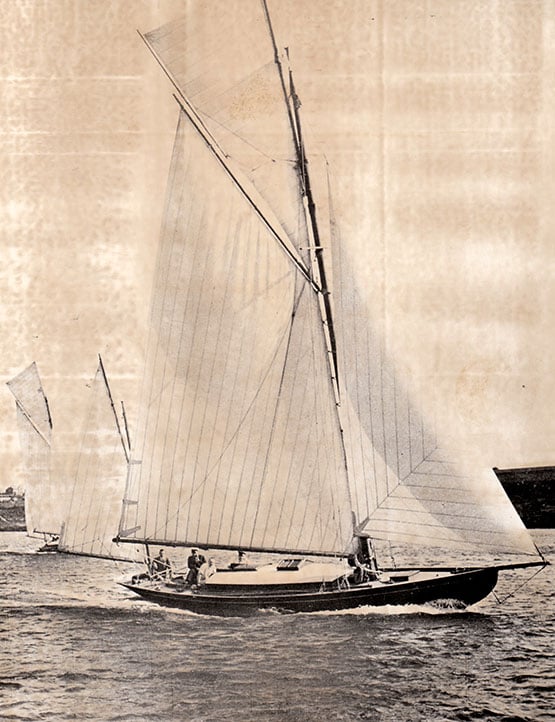 The island Class yawl Trasnagh, seen here in her first season of 1913, is believed to be the last boat to have been built by John Hilditch. Photo: Courtesy RNIYC
The island Class yawl Trasnagh, seen here in her first season of 1913, is believed to be the last boat to have been built by John Hilditch. Photo: Courtesy RNIYC
The last of them, Trasnagh herself in 1913, was the last boat to come out of a formerly great yard rapidly tumbling towards extinction. The times were restless politically as well as economically, so it wasn’t a good time to rely on building pleasure boat for a living. And apart from the saturation of the market and the financial demands of building the relatively large Island Class boats, sailing was no longer attracting the same number of newcomers, as rival interests such as motor cars and aeroplanes were taking away many potential enthusiasts,
Yet ironically, had John Hilditch been able to hang on for just another year into the beginning of the Great War of 1914-18, a slew of war work for the Admiralty would have given his yard a new lease of life. But it was not to be. The yard was gone. And soon, so too was the man himself.
But the boats live on. One hundred and two years after John Hilditch’s death, boats that he created are still sailing the seas, and their assembly in Belfast Lough from June 22nd 2016 onwards will be a reminder that, once upon a time, on a site long since covered by Carrickfergus’s re-developed waterfront, John Hilditch and his team built nearly a hundred fine yachts, the best of which have well stood the test of time. All that together with the 150th Anniversaries of two remarkable sailing clubs. For sure, late June on Belfast Lough is going to be one very special time.
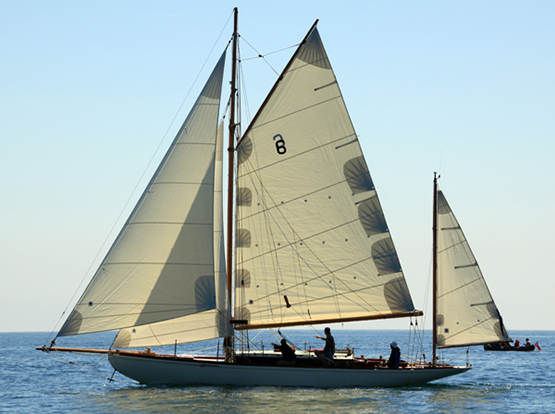
Trasnagh restored for her Centenary in 2013



























